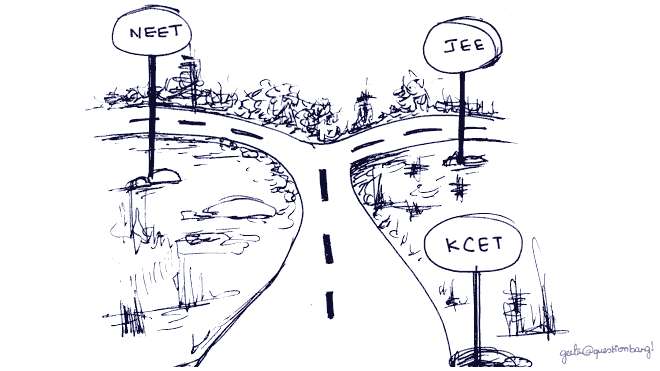“The toughest battle you’ll ever fight in your life is the battle within yourself.” – Anonymous
An exam toughness is subjective, it may be difficult to quantify. Any opinion based on past feedback may not be valid for future exams. We try to compare three popular exams – NEET, JEE and KCET using some past data. Please take this analysis with a pinch of salt!
Toughness parameters
Let us assume, the toughness of any competitive exam is going to depend upon following two factors:
1. Competitiveness – Number of applicants v/s available seats,
2. Difficulty level –
a. Quality of questions,
b. Average time available for solving a question.
Competitiveness
The table below shows three exams and the number of applicants. This data has been taken from online news portals or blogs. These figures are for the year 2016 – 2017, may not be accurate.
The last column is a ratio of 2nd and 3rd column values,
Competitiveness = Number of applicants / available seats.
| Exams | No of applicants (approx) | Available seats | Competitiveness |
| JEE | 12 lakh | 18,000 | 66.67 |
| NEET | 11 lakh | 25,000 | 44.00 |
| KCET | 1.50 lakh | 83,000 | 1.81 |
Surely JEE is more competitive than NEET, there are more applicants per available seat.
Difficulty level
The quality of questions can be low, moderate or high and can be subjective.
The difficulty level of any exam will be such that an applicant should be able to attend all questions in an allocated time. This is how all the boards or examination authorities would set the question papers. Hence, we can use the average time allocated for a question as an indicator of difficulty level.
Difficulty level = Average time allocated to solve a question.
The table below shows maximum duration, number of questions and difficulty level.
| Exams | Duration (in minutes) | No of questions | Difficulty level (Average time in minutes) |
| JEE | 180 | 90 | 2.0 |
| NEET | 180 | 180 | 1.0 |
| KCET | 180 | 180 | 1.0 |
As we can see, only JEE Mains allocates 2 minutes for a question and the difficulty level is considered to be highest among all exams.
The difficulty level of NEET and KCET are moderate based on the quality of questions.
The JEE and NEET are somewhere between high and moderate, on a difficulty scale.
Toughness Index
We now want to combine difficulty level and competitiveness to compute a toughness index. The assumption is – a higher difficulty level will weed out poorly prepared or less serious applicants, and hence may reduce the competitiveness.
We hope this is not contradicting any proven theory.
Toughness Index = (Competitiveness +- x ) / ( Difficulty level +- y),
x and y are correction factors to address any errors (or bias) in our assumptions. Let us neglect x and y; x = 0, y = 0,
Toughness Index = Competitiveness / Difficulty level.
| Exams | Competitiveness | Difficulty level | Toughness Index |
| NEET | 44.00 | 1.0 | 44.00 |
| JEE | 66.67 | 2.0 | 33.34 |
| KCET | 1.81 | 1.0 | 1.81 |
It does look like NEET is tougher than JEE.
Note: We answered a question on Quora where MHCET and GUJCET have also been compared:
How tough is the GUJCET compared to the MH CET (engineering)?
